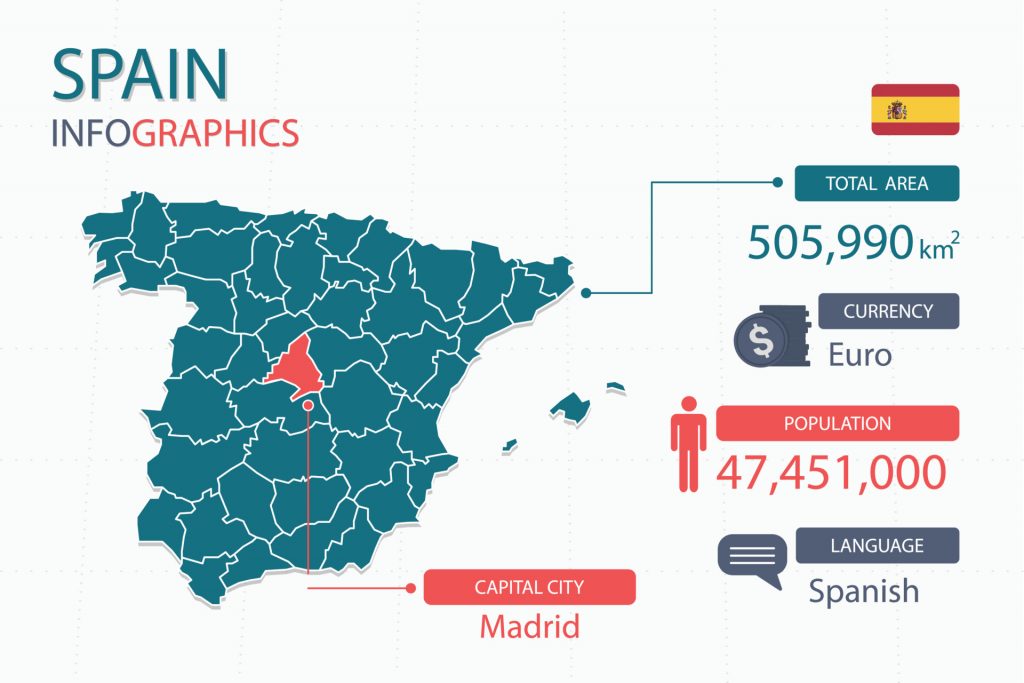The origins of the Spanish Language
Spanish language, also known as the Castilian language (Castellano) is a major world language, being the world’s second most spoken language, after Mandarin Chinese, boasting around 570 million speakers. Because of the pursuits of the Spanish Empire throughout the 16th and 17th centuries, it is spoken in a large number of countries including countries in Europe, the Americas, and also in some former territories in Africa, Oceania, and the Philippines. It is the official language of 19 countries in the Americas and the national language of both Spain and Equatorial Guinea. It is one of the six official languages of the United Nations, and an official language in major international organizations including the European Union, the Organization of American States, and the Union of South American Nations, among a plethora of others.
Being a language that is spoken over a vast area of the world, the development of the Spanish language over a variety of regions in the world has led to many dialectal differences, even though most standard versions are mutually intelligible. Similarly to English, it is a pluricentric language, with more than one standard variety, usually conceptualized as a European standard and a Latin American standard. Some features that may surprise learners of the language are its gender classification system for nouns (male and female) and the pro-drop characterization of the language. This means that subjects are not needed for a grammatically correct sentence. In addition, a tense-aspect verb system that is very similar to other Romance languages exists. In comparison to other languages, this system can be characterized as more complex than those of a majority of the world’s languages.
Similar to all Romance languages, Spain is a descendent from Vulgar Latin, the colloquial Latin that was spoken during ancient Roman times and the Holy Roman Empire, as opposed to the formal register that was used for administrative and official purposes at the time. Other influences that have shaped the Spanish language, especially in terms of vocabulary include Arabic, from the Moorish invasions and other contact with Arabian kingdoms, Basque, Celtic languages, Germanic languages, and Greek. Of course, the vocabulary of neighboring countries and regions in Europe have also contributed to the development of Spanish, such as vocabulary that may have roots in French, Italy, Spain, etc. In terms of the development of Spanish in the Americas, vocabulary has entered the standard varieties there due to contact with Native American cultures and their languages as well. For example, many words rooted in Aztec have influenced Mexican Spanish and are used on a daily basis by speakers of this variety of Spanish.

The Spanish writing system utilizes the Latin script, containing one more letter than the common 26, the eñe (ñ), bringing the total number of letters to 27. Up until 2010, ch and ll were also considered separate letters, but spelling reforms have eliminated this. Spanish, like all the Romance languages is written and read from left to right, and from the top of the page to the bottom of the page. Another interesting note about the alphabet is the names of the letters. Again, as Spanish is spoken in such a variety of countries, this may affect what the letters are known as, such as with the case of Z in American English as compared to other varieties of English (zee vs. zed). Another interesting fact is how the letter B and V are pronounced. In essence, they represent the same exact pronunciation, even though there might have been historical differentiations. For example, the words hierba and hierva are pronounced in the exact same manner. Their usual names are be and ube, but in Latin America, there are a number of ways to say the name of these letters.
Deriving from Vulgar Latin, the beginnings of Spanish was the colloquial Latin varieties that have evolved into the language that was spoken in the region of Castile after the decline of the Roman Empire. The prominence of heroes and legends that were Castilian, and the poetry that celebrated them, led to the Castilian variety having a higher prestige and respect.
Starting in the 13th century, there was a standardization of Castilian, and this ‘Old Spanish’ resembles quite a bit the modern written language. First, a 13th century king, Alfonso X of Castile, assembled scribes to produce works in a variety of academic fields of knowledge, supervising and guiding their writing in Castilian. Second, the first grammar of Spanish was written by Antonio de Nebrija, and it was presented to Queen Isabella. These two occurrences helped solidify Old Spanish into the Spanish that it would become today because of extensive documentation.
In 1713, the founding of the Spanish Royal Academy, an institution whose purpose was to offer a standard and prestigious version of the language, carved a path to regulation and propagation of the Spanish language. The Academy started publishing a dictionary in 1726 and continues to do so during present times as well.
The development of Spanish is unique because of the endeavors of the Spanish Empire, beginning in the 16th century. Invasions and colonization of vast parts of the Americas and the Pacific, including the Philippines, Palau, and the Marianas spread the language to these parts of the world. At the same time, the local cultures and languages interacted with Spanish to affect its development. As mentioned above, vocabulary and grammar from Native American languages entered the Spanish used in these areas. Even after colonization, use of Spanish continued through the descendants of both the Spaniards and the native people of the areas, with the language becoming part of the local identity, especially in the Americas. As a result, , Spanish is nowadays a first and official language of many of the new Republics that formed in Central and South America.
In modern times, it continues to be a major language that represents a large number of cultures and national identities. Pop and music culture that uses the Spanish language is vast and international, and it is a prominent language in an array of media. More importantly, it acts as a lingua franca among the Spanish speaking countries and communities of the world.
VEQTA can provide you with a perfect Spanish translator for your Spanish translation, English to Spanish translation and Spanish to english translation for the your targeted locale. Our translations to Spanish are created with your target audience in mind to meet your expectations.
If you need to translate Spanish – Get in touch today!
A dedicated team of Spanish translators who combines Experience, Specialized Subject Matter Expertise with Translation Practices to deliver quality second to none.
Spanish Subject Expertise
Spanish Translators
Spanish Editors
Spanish Copywriters
Spanish Reviewers
Spanish Voice dubbing
Spanish Subtitling
Spanish Transcription


